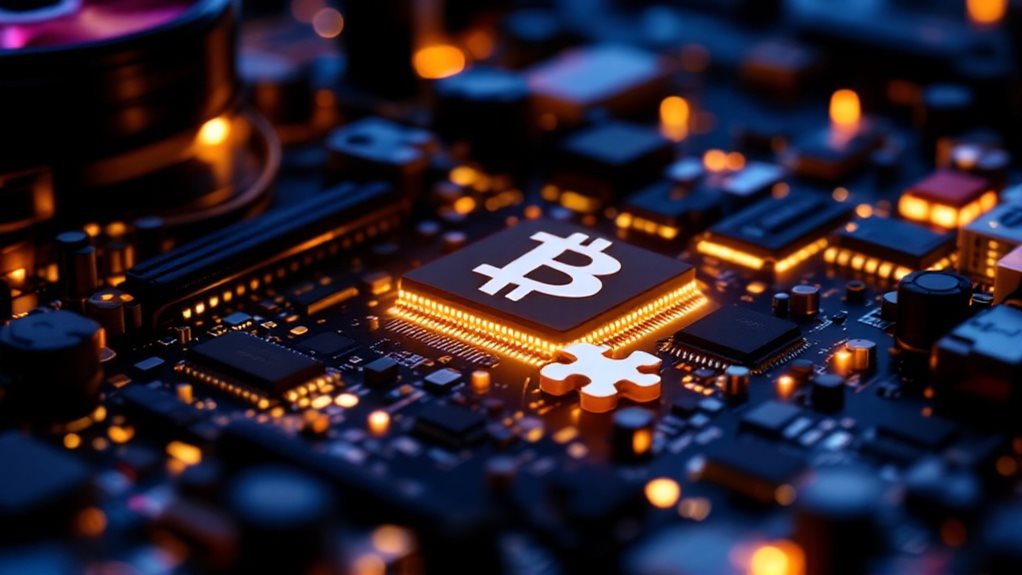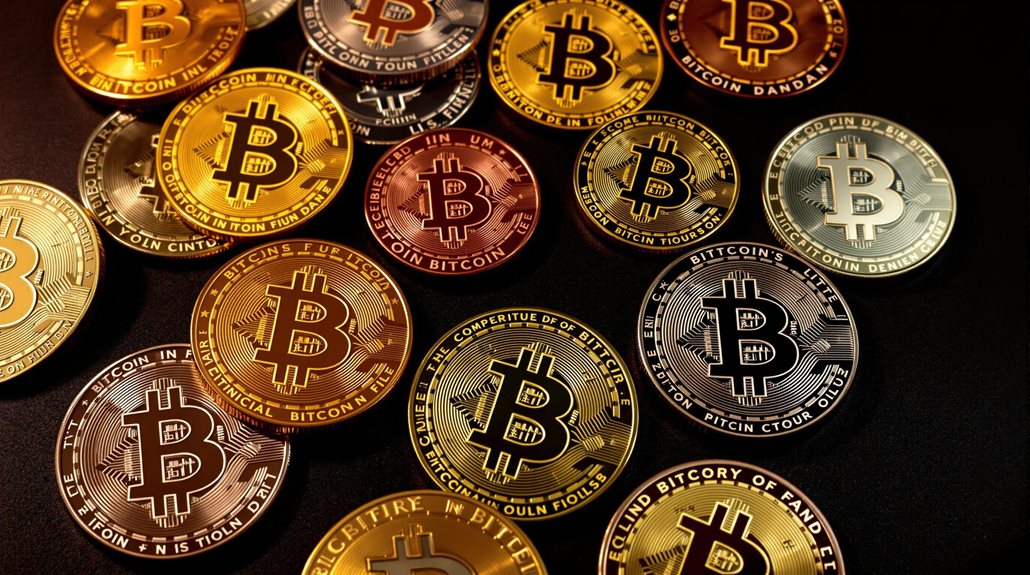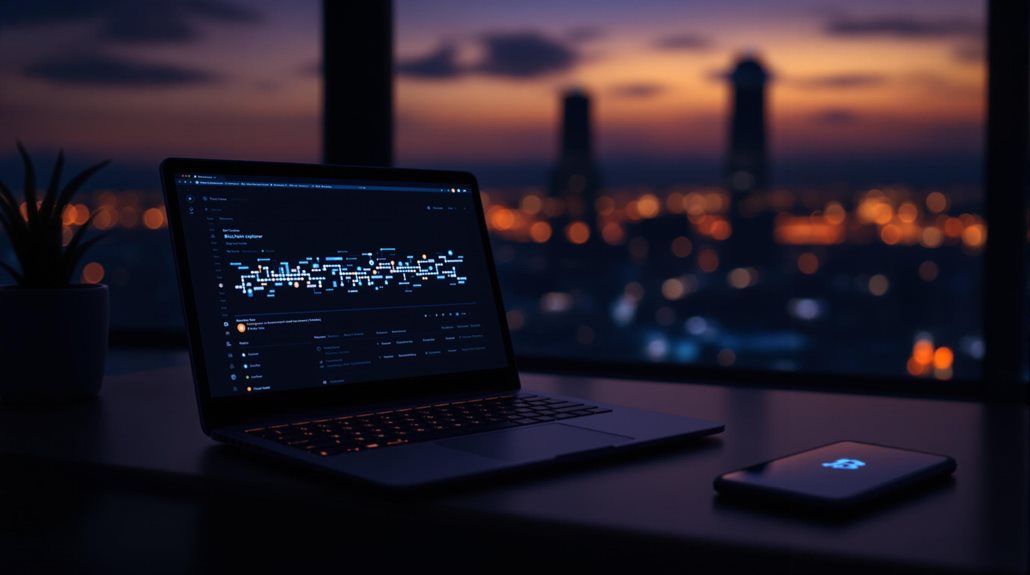Bitcoins aren't physical objects – they're digital entries in a computer network called the blockchain. Created by Satoshi Nakamoto in 2008, bitcoins exist as secure, encrypted data that's verified and tracked across thousands of computers worldwide. The smallest unit is called a satoshi, which is one hundred millionth of a bitcoin. Like traditional money, bitcoins are durable and can be exchanged, but they operate without banks or government control. There's much more to discover about this revolutionary digital currency.

Unlike paper money that you can hold in your hand, bitcoins aren't physical objects at all. They exist only as digital entries in a special type of database called a blockchain. Each bitcoin can be divided into tiny fractions, with the smallest unit being one hundred millionth of a bitcoin, known as a satoshi. This digital currency isn't created or controlled by any bank or government – instead, it operates through a decentralized network of computers worldwide. Created by Satoshi Nakamoto in 2008, Bitcoin revolutionized digital transactions by eliminating the need for intermediaries.
The creation of new bitcoins happens through a process called mining, but miners aren't digging in the ground – they're using powerful computers to solve complex mathematical puzzles. When these puzzles are solved, new transactions are verified and added to the blockchain about every 10 minutes. Miners who successfully solve these puzzles receive newly created bitcoins as a reward, along with fees from the transactions they've processed. These mining rewards started at 50 Bitcoin per block in 2009 and have been decreasing over time through scheduled halvings. The first major advancement in mining technology came when Hashcash proof-of-work was integrated into the Bitcoin protocol.
The blockchain serves as a public record of every bitcoin transaction ever made. It's like a giant digital ledger that everyone can see but nobody can alter without proper verification. Each block in the chain contains transaction data and is linked to the previous block through a unique code called a hash. This system makes it impossible for someone to spend the same bitcoin twice or create fake transactions. The Mt. Gox hack showed how vulnerable exchanges can be when proper security measures aren't maintained.
Bitcoin's value comes from its limited supply and market demand. There will only ever be 21 million bitcoins in existence, making it similar to precious metals regarding scarcity. While traditional money can be printed in unlimited quantities by governments, bitcoin's supply is fixed by its programming. This digital currency has several characteristics that make it function like money – it's durable (it can't wear out), portable (it can be sent anywhere instantly), and fungible (each unit is equal to another).
When people trade bitcoins, their transactions are secured using advanced cryptography, which is like a sophisticated digital lock and key system. While these transactions are recorded on the public blockchain, they're pseudonymous, meaning they're not directly tied to people's real identities. However, they're not completely anonymous, as transactions can sometimes be traced through various means.
People can buy and sell bitcoins on special exchanges, converting them to traditional currencies like dollars or euros.
Frequently Asked Questions
How Do I Protect My Bitcoin Wallet From Hackers?
Bitcoin wallet security relies on several key practices.
Users protect their wallets by using two-factor authentication, complex passwords, and biometric features like fingerprint scanning.
They keep most funds in offline cold storage and use hardware wallets for large amounts.
It's common to encrypt wallet backups, avoid public Wi-Fi, and never share private keys.
Regular software updates and antivirus protection also help prevent unauthorized access to digital assets.
Can Governments Track Bitcoin Transactions and Identify Users?
Yes, governments can track Bitcoin transactions and identify users through several methods.
They use blockchain analysis tools to trace transactions and cluster related addresses. When people buy or sell through exchanges that require ID verification, it creates links between Bitcoin addresses and real identities.
They also work with crypto businesses to gather user information. While privacy tools exist, most Bitcoin activity isn't completely anonymous.
What Happens to Lost Bitcoins After Someone Dies?
When someone dies and their Bitcoin private keys are lost, those bitcoins become permanently inaccessible.
They're still visible on the blockchain, but no one can spend or move them.
It's like having a safe full of money but no key or combination to open it.
The lost bitcoins stay frozen forever in their digital wallets.
This has already happened to millions of bitcoins, worth billions of dollars, which are now stuck in limbo.
Will Bitcoin Mining Remain Profitable as Block Rewards Decrease?
Bitcoin mining's profitability will likely continue but in different ways.
As block rewards decrease through halvings, miners can still make money through transaction fees and higher Bitcoin prices.
Many miners are also finding new revenue streams, like hosting AI services.
Mining costs are getting lower thanks to better technology and cheaper renewable energy.
While it's getting harder to mine Bitcoin, the industry keeps adapting to stay profitable.
Can Quantum Computers Break Bitcoin's Encryption in the Future?
Quantum computers could potentially break Bitcoin's encryption in the future, but they're not powerful enough yet.
Experts say it would take about 13 million qubits to crack Bitcoin's security, while today's quantum computers are far less capable.
About 25% of all Bitcoins might be at risk when quantum computers become more advanced.
However, the crypto community is already working on quantum-resistant solutions to protect Bitcoin before this becomes a real threat.





